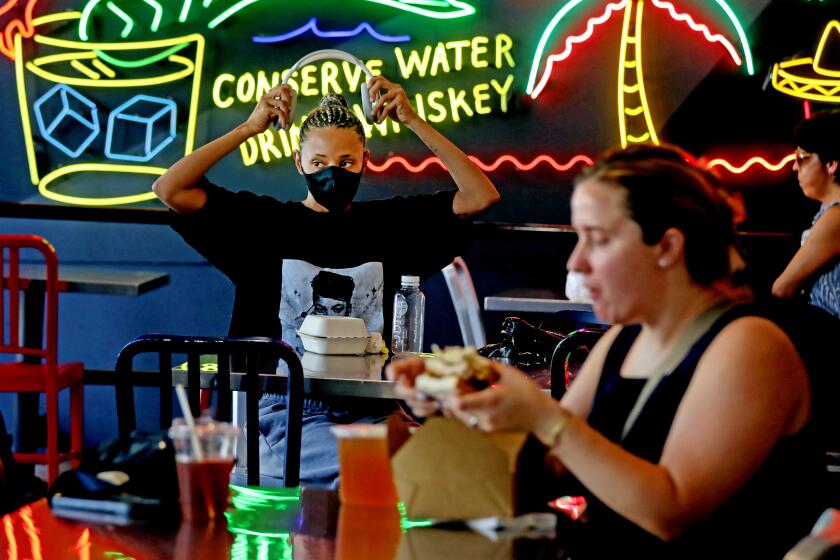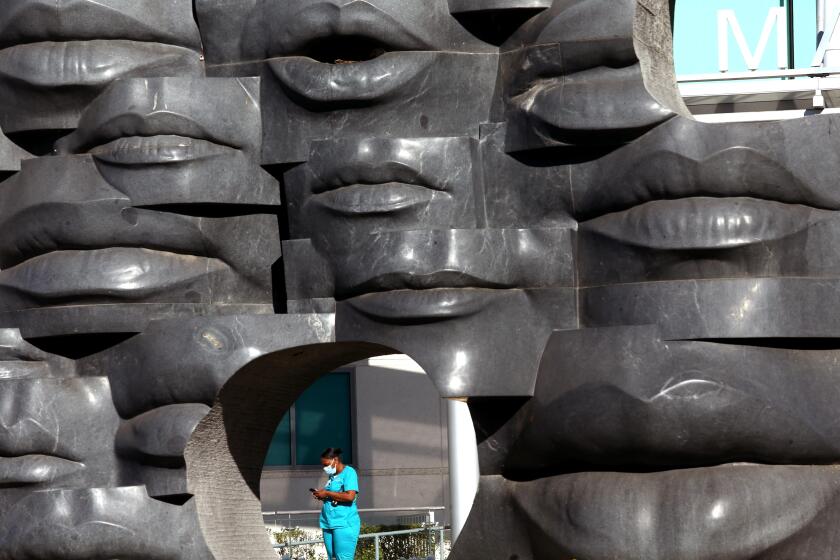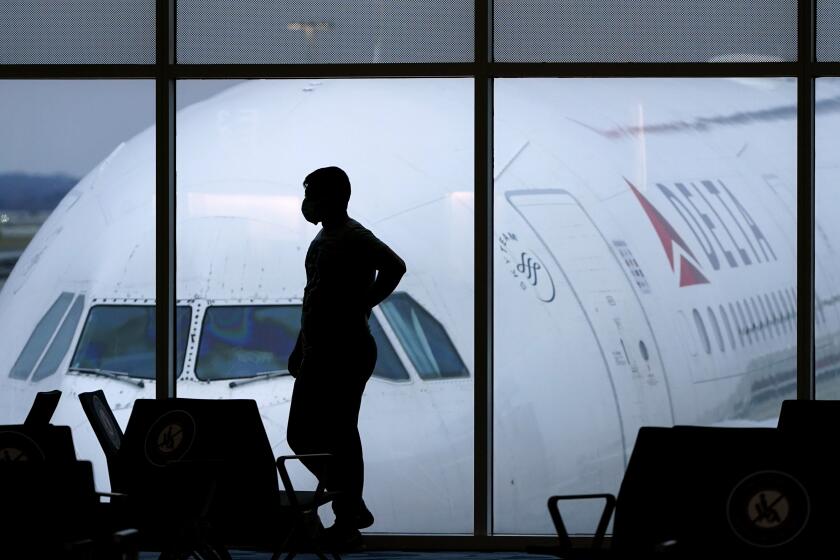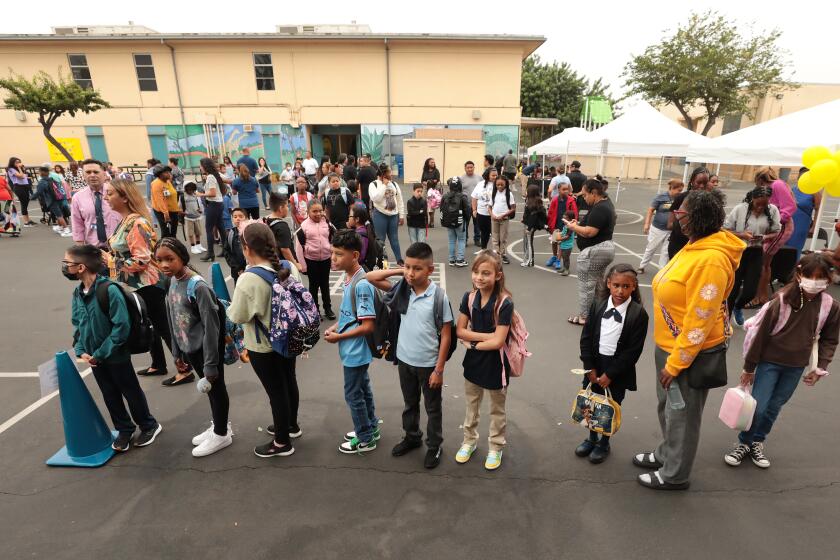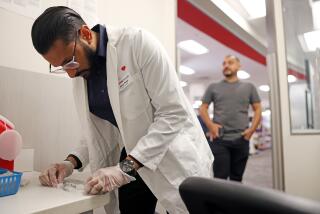New COVID vaccine, due as early as next week, appears to work well against Pirola subvariant

- Share via
One of the new COVID-19 vaccines that could come out as soon as next week appears to provide strong protection against the latest upstart subvariant, experts say — a reassuring sign as manufacturers and public health officials work to stay on top of the still-swirling coronavirus.
The U.S. Centers for Disease Control and Prevention has been concerned that the unusually high number of mutations seen with BA.2.86, nicknamed Pirola, might make the strain able to more easily infect those who had previously caught the coronavirus or received an older vaccine formulation.
Wednesday saw the arrival of updated vaccine data that doctors had eagerly awaited. And the results were promising.
This year’s version of the COVID-19 vaccine made by Moderna “generates a strong human immune response against the highly mutated BA.2.86,” Dr. Stephen Hoge, president of the Massachusetts-based pharmaceutical company, said in a statement. “These data confirm that our updated COVID-19 vaccine will continue to be an important tool for protection as we head into the fall vaccination season.”
Coronavirus levels have more than doubled in Los Angeles’ wastewater since the start of summer, state data show.
Clinical trial data suggest that the forthcoming formula generated a strong antibody response against circulating variants, including BA.2.86, according to the vaccine maker.
The upcoming fall vaccines were designed against the version of the coronavirus that was dominant earlier this year: XBB.1.5, unofficially known as Kraken. But questions have swirled around how much protection that formulation might afford against the far-more-mutated BA.2.86.
“It’s really good news,” Dr. Peter Chin-Hong, a UC San Francisco infectious-disease expert, said of the Moderna data. “I think it should be reassuring for people.”
There were early concerns that BA.2.86 may be more immune-evasive than even previous members of the sprawling Omicron coronavirus family. But so far, the strain has yet to forge a clear path toward dominance, either locally or globally.
BA.2.86 is not yet prevalent enough to be listed on the CDC’s variant tracker. To get there, a variant needs to comprise more than 1% of cases nationally over at least a two-week period.
As of last week, there had not been any cases of BA.2.86 in California, “and at this point, there is no evidence that this strain is causing more-severe illness,” according to Los Angeles County Public Health Director Barbara Ferrer.
With coronavirus transmission on the rise, the FDA said this year’s updated version of the COVID-19 vaccine is likely to come out by the middle of next month.
New York-based Pfizer and its German partner BioNTech are also planning their own updated COVID-19 vaccination, as is Maryland-based Novavax.
Nationally, the most dominant Omicron subvariant at the moment is EG.5, also known as Eris. That strain comprised an estimated 21.5% of infections nationwide from Aug. 20 to Saturday, CDC data show. It’s expected that the new autumn vaccines will work well against EG.5, experts say.
Doctors widely expect that the newly updated COVID-19 vaccines could be available as early as next week.
A key step will occur Tuesday, when the CDC’s Advisory Committee on Immunization Practices meets. A vote from that meeting, followed by an official recommendation from CDC Director Dr. Mandy Cohen, would effectively open the gateway for clinicians to start administering any of the three manufacturers’ new vaccinations.
It’s possible the Eris subvariant, formally known as EG.5, may have even further immune-escape advantage than other members of the Omicron coronavirus family.
NBC News reported that the U.S. Food and Drug Administration could greenlight the new COVID boosters as early as Friday. Typically, though, clinicians wait for subsequent action by the CDC before administering the shots.
Clinicians say getting an updated shot will be especially important for those at higher risk for severe illness. Most of those being hospitalized for COVID-19 are older people who are not current on their vaccinations.
Insured people will be able to get the new COVID vaccine at no cost, and uninsured children will be able to get the vaccine free through the federal Vaccines for Children program.
Uninsured adults can get free COVID vaccinations through certain health clinics and pharmacies, as well as the L.A. County Department of Public Health. L.A. County will publish a list of locations as soon as it’s available.
Higher rates of coronavirus transmission are leading to more COVID-19 outbreaks in Los Angeles County, with nursing homes, schools and worksites reporting increases in recent weeks.
COVID-19 levels are increasing in California and across the nation, although they remain near historic lows. Nonetheless, the rise in infections is proving to be highly disruptive in some settings. Higher rates of coronavirus transmission are leading to more COVID-19 outbreaks in L.A. County, with nursing homes, schools and worksites reporting increases in recent weeks.
Coronavirus levels also are rising in L.A. County wastewater, but are still nowhere near last winter’s surge. For the most recent data available, levels for most of the county’s sewage were at 26% of last winter’s peak. That’s an increase from early July, where viral concentrations in wastewater were at just 8% of the winter peak.
Despite the increase in coronavirus transmission, there hasn’t yet been a corresponding increase in COVID-19 deaths, which remain at one per day in L.A. County. Rising infections could lead to an increase in deaths, but Ferrer said it’s also possible that deaths remain low, which “could reflect reduced risk of dying associated with higher rates of vaccination and the use of powerful therapeutics” such as Paxlovid.
Health officials say it’s still prudent to take reasonable steps to avoid getting infected. Ferrer suggested that people wear masks while on public transit and in healthcare settings, and urged that sick people stay home.
More to Read
Sign up for Essential California
The most important California stories and recommendations in your inbox every morning.
You may occasionally receive promotional content from the Los Angeles Times.
